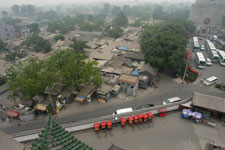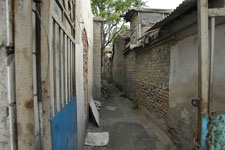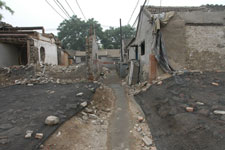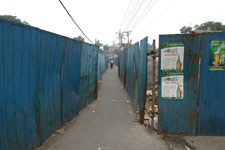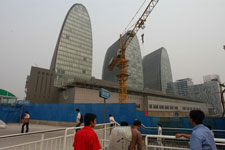|
IMAGING BEIJING |
 (a) Your name, email address, country, and web site URL (if you have one). John Craig Freeman john_craig_freeman@emerson.edu U.S.A. http://johncraigfreeman.net (b) A description of the project's core concept (250 words maximum). "Imaging Place," is a place-based, virtual reality art project. It takes the form of a user navigated, interactive computer program that combines panoramic photography, digital video, and three-dimensional technologies to investigate and document situations where the forces of globalization are impacting the lives of individuals in local communities. The goal of the project is to develop the technologies, the methodology and the content for truly immersive and navigable narrative, based in real places. The project has been under development since 1997 and includes work from around the world including Taipei Taiwan, São Paulo Brazil, Kamloops BC Canada, Warsaw Poland, the U.S./Mexico Border, Fort Point MA, Lowell MA, the Miami River, Haverhill MA, Niagara, New England, Appalachia, and Florida. The work, in its installation form, is projected up to nine by twelve feet in a darkened space with a pedestal and a mouse placed in the center of the installation enabling the audience to interact with it. Activated by the click of a mouse button, the interface leads the user from global satellite images to virtual reality scenes on the ground. Users can then navigate an immersive virtual space. 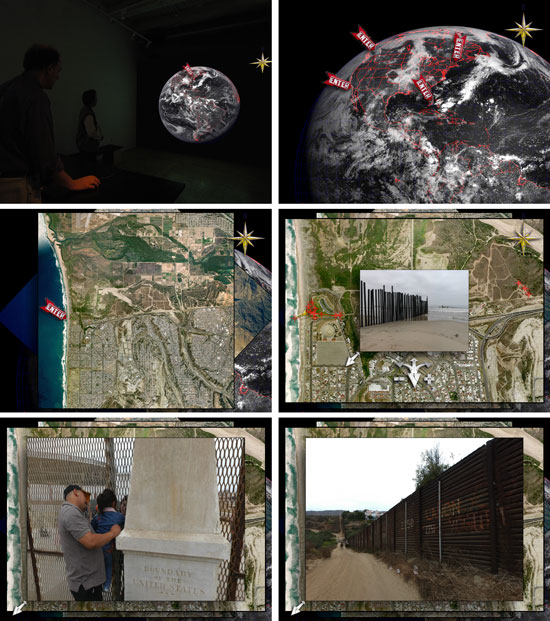 Recently, I have been implementing the project in Second Life. When an avatar first arrives at an Imaging Place SL Scene he, she or it sees on the ground a large black and white satellite picture of the full disk of the Earth. The avatar can then walk over the Earth to a thin red line which leads to an adjacent higher level platform made of a high resolution aerial photograph of specific location from around the world. 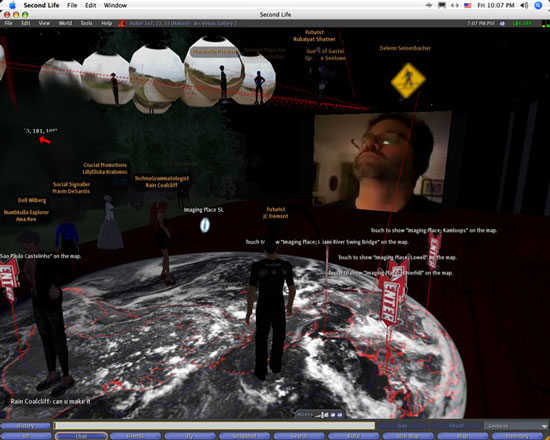 Mapped to the aerial images are networks of nodes constructed of primitive spherical geometry with panoramic photographs texture mapped to the interior. The avatar can walk to the center at one of these nodes and use a first person perspective to view the image, giving the user the sensation of being immersed in the location. Streaming audio is localized to individual nodes providing narrative content for the scene. This content includes stories told by people who appear in the images, theory and ambient sound.  When the avatar returns to the Earth platform, several rotating enter signs provide teleports to other "Imaging Place" scenes located at other places within the world of Second Life. |
|
(c) Details of how the project will be realized, including what software / programming will be used. Please address all of these questions. [Turbulence server specs are available here. You may request additional software but we cannot guarantee it.] Phase 1) Field Research and Production: First I will travel to Bejing to generate the content for the project. I will arrange to meet with denizens of the location and have them help me map and document movement through the space, collecting narrative content, testimonials and accounts of history as we go. I intend to use the Turbulence.org web site to post the results of the field research and production phase of the project with daily blogs, maps and pod-casts in realtime and to solicit participation of others with comment functions and rich media drop boxes using PHP and MySequal . I will generate a database of material which will be tagged, linked, written about, and, in other ways, interacted with so that people will be able to follow the progress of the project as it unfolds. I will need to build a map-type interface so that this archive can be organized spacially. Phase 2) Exhibition: The material will then be assembled into its exhibition formats for both the real world exhibition at Art Interactive and the virtual world exhibition at Ars Virtua. The virtual world installation will be projected into the gallery space at Art Interactive. A special avatar will be created in Second Life for visitors of Art Interactive to use to navigate the Imaging Place scene at Ars Virtua. This avatar's mobility will be restricted to the virtual installation and the Second Life interface will be strip down to just the camera view and chat so that visitors to the real world installation do not wander off into arbitrary Second Life locations. This avatar will wear a steaming video screen as a mask which will broadcast a live web-cam video of the current users face into Second Life. This user will also be able to talk to other avatars using voice. 
(d) Names of collaborators, their areas of expertise, and their specific roles in the project. My primary collaborator will be Gregory L. Ulmer. Ulmer's work focuses on hypertext, electracy and cyberlanguage and is frequently associated with "emerAgency", "fetishturgy," "choragraphy" and "mystoriography." He is the author of 'Applied Grammatology: Post(e)-Pedagogy from Jacques Derrida to Joseph Beuys; Teletheory: Grammatology in the Age of Video; Heuretics: The Logic of Invention; Internet Invention: From Literacy to Electracy; and Electronic Monuments. Following his motto (from the Japanese poet Matsuo Basho) "not to follow in the footsteps of the masters, but to seek what they sought," Ulmer developed a mode for research and pedagogy that does for electracy what the argumentative essay (paper) does for literacy. (e) A project budget. Include shipping expenses and insurance (if any). You are encouraged to find additional support for this project. Artist fee John Craig Freeman, Project Director $ 1,000. Travel from Boston to Beijing $ 2,500. Consultant fees product and function specifications programmer $ 500. Open-source developer $ 500. Metadata consultant $ 500. Computer, video and telecommunications equipment $ 1,000. TOTAL PROJECT COSTS $ 5,000 (f) Your resume/CV and one for each of your collaborators. (g) Up to five examples of prior work accessible on the web. Imaging Place. A small sample movie. Some still images. Imaging Place in Second Life Imaging Place; The U.S./Mexico Border at Ars Virtua, 2007. |
